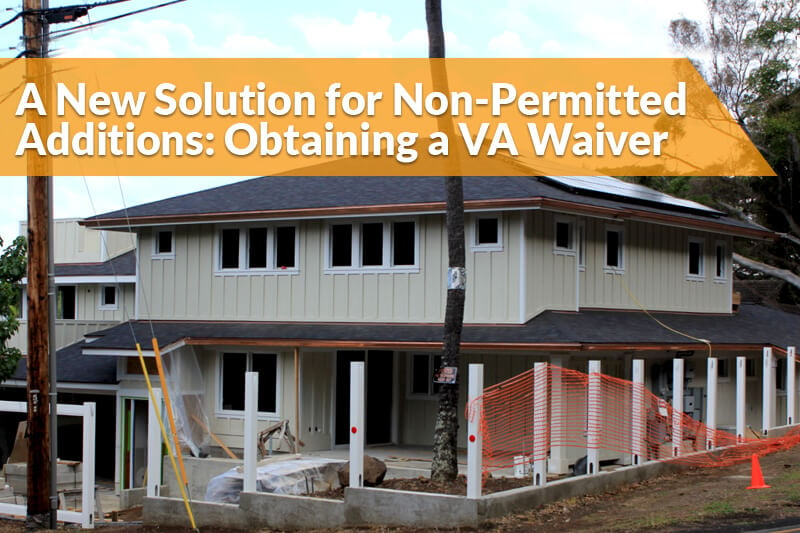UPDATED 8.3.17: As of July 10, 2017, appraisals with permit issues (as long as they meet the VA’s Minimum Property Requirements) will be issued “As is.” This means that the lack of an existing permit for an addition or improvement will not prevent a home from obtaining VA financing, and it will no longer be necessary to obtain a VA waiver for homes that were not properly permitted. However, the appraiser will not give value to the non-permitted area. Read more HERE.
Therefore, the information in the post below does not reflect the new guidelines for non-permitted additions. Instead, go here: https://hawaiivaloans.com/new-non-permitted/.
______________________________________________________________
There’s a new solution for your non-permitted addition woes! First, let’s say that you’ve been approved for a VA home loan and your offer has been accepted on a great home for you and your family. During the appraisal process, the VA appraiser comes in and discovers that a deck on the home was not permitted, thus halting the VA loan home buying process for you.
In our previous blog post, How to Overcome a Non-Permitted Addition and Get Your VA Loan, we gave you two solutions for overcoming a non-permitted addition in order to get your VA loan: 1) obtaining a retroactive permit or 2) tearing down the addition. Well, we have an update for you! Not too long ago, the local VA office announced a third solution that is sure to ease the minds of homebuyers who face these non-permitted scenarios: obtaining a VA waiver.
How Can a Waiver Be Obtained?
The following guidelines must be met in order to apply for a VA waiver:
- If the property is located in a jurisdiction that enforces State, county or local building code, then VA Minimum Property Requirements (MPRs) require that the construction/addition comply with the applicable building code.
MPR variations and exemptions may be waived for existing structures with the following documentation:
- Veteran is under contract to purchase the property, and
- The veteran and lender request the exemption in writing, and
- The property is habitable from the standpoint of safety, structural soundness and sanitation, and
- VA is satisfied that the noncomformity has been fully taken into account by way of depreciation in the VA valuation.
The VA will also require:
- A hold harmless letter from both the veteran and the lender stating and showing the unpermitted areas.
- Acknowledgement from the veteran that the unpermitted areas are the veteran’s responsibility to cure before refinance/sale of the property, and
- Official letter from the current licensed contractor, electrician, plumber, or engineer that the work was completed in compliance with City and/or County building codes.
Recently, VA Loan Specialist, Brandi Brickler, worked with a Hawaii VA Loans client to successfully obtain a waiver on their future home.
“The process was very easy. The most important thing is to make sure that all non-permitted additions are disclosed up front,” Brandi said. “Usually, we can do that by checking the MLS listing against the property tax records to make sure there are no discrepancies in square footage. In our case there was a slight variation in square footage and the seller disclosed that up front.”
Together, Brandi and her clients followed the guidelines for document submission and included photos of the addition for the VA to review. A week after submitting their exemption to the VA, a waiver was granted and her clients were able to continue on the path to homeownership.
There you have it! Each MPR variation or exemption will be looked at on a case by case basis. As long as the borrower meets the guidelines detailed above, they can obtain a VA waiver for a property’s non-permitted addition and get their VA loan!
For any questions you have about the VA loan process, don’t hesitate to contact us at 808-792-4251.


